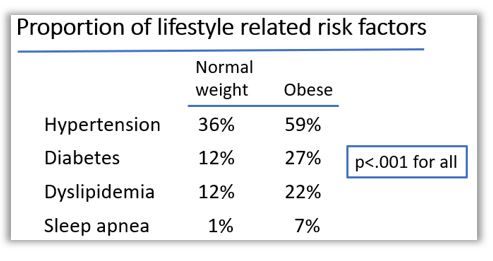- Clinical Technology
- Adult Immunization
- Hepatology
- Pediatric Immunization
- Screening
- Psychiatry
- Allergy
- Women's Health
- Cardiology
- Pediatrics
- Dermatology
- Endocrinology
- Pain Management
- Gastroenterology
- Infectious Disease
- Obesity Medicine
- Rheumatology
- Nephrology
- Neurology
- Pulmonology
Obesity Common Among Adults Aged <50 Years with Acute Ischemic Stroke, Study Finds
Nearly two-thirds of persons aged younger than 50 years who had an acute ischemic stroke had obesity in a study presented at the 2022 International Stroke Conference.
©CLIPAREA/stock.adobe.com

A majority of acute ischemic stroke (AIS) patients aged <50 years were found to be obese in a new study of “young AIS” presented on Wednesday, February 9, at the annual International Stroke Conference, held February 9-11, 2022.
Study authors also report that patients with obesity had the highest proportion of all medical risk factors, as well as a risk factor burden nearly twice as high as those with normal BMI.
Previous research, they write in the study abstract, suggests that the association between obesity and AIS in adult and young (<50 years) persons is mediated through other risk factors including diabetes and hypertension. The extent of that association, however, is not fully characterized. The aim of the current study was two-fold: identify the association between obesity and young AIS and identify the burden of lifestyle-related risk factors on standard body mass index (BMI) measures of obesity.
The patient population consisted of all patients with AIS, aged <50 years who were admitted to the University of Maryland Medical System hospitals from 1/2017 to 12/2020. Researchers categorized participants by BMI into 3 groups: Normal (18.5-24.9 kg/m2), overweight (25-29 kg/m2), and obese (≥30 kg/m2). Using Chi-Square tests, they analyzed the burden and distribution of lifestyle-related risk factors (hypertension, diabetes, dyslipidemia, sleep apnea) across the 3 BMI categories followed by a test for mean differences in number of risk factors across the 3 categories.

Investigators identified 1272 patients with young AIS. Among them, 63% were obese and 23% were in the overweight group. The mean age of the patients in the obese group was 41.4 years (SD +/- 6.75), 49.4% were women and 53.4% were Black. The risk factor burden in the obese vs the overweight and normal weight categories was significantly higher (p<.001). The proportion of patients with each of the lifestyle-related risk factors of interest was at least 2 times higher in the obese group vs the normal weight group (see figure).
The authors summarize their findings by noting that a majority of the young AIS patients in the study cohort were obese and that patients with overweight/obesity were predominately Black. They suggest that given high proportion of medical risk factors for stroke among the obese in addition to the overall risk factor burden of these patients, “Efforts to reduce obesity hold promise in mitigating the burden of stroke in young adults.”
Reference: Solomonow J, Yarbrough LK, Chaturvedi S, Mehndiratta P. Is obesity driving the increase in young stroke? Stroke. 2022;53(suppl1)WP277.
